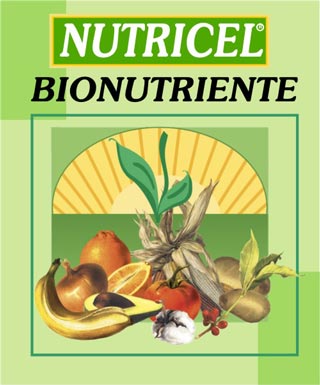| Average composition of aminoacids
L-ALFA (g/100 of product) |
|
| Alanine: 3,53 | Lysine: 1,72 |
| Arginine: 2,51 | Methionine: 0,31 |
| Aspartic acid: 2,20 | Phenylalanine: 0,94 |
| Cysteine: 0,16 | Proline: 5,41 |
| Glutamic acid: 4,08 | Serine: 0,71 |
| Glycine: 9,88 | Threonine: 0,39 |
| Hydroxyproline: 3,21 | Tryprophan: 0,16 |
| Histidine: 0,47 | Tyrosine: 0,55 |
| Isoleucine: 0,63 | Valine: 1,02 |
| Leucine: 1,41 | |
| Total: 39,28 | |
|
|
|
• Faster and improved development
of the root's system • Accelerated plant's growth • Earlier budding • Improved fruit setting • Higher quality and increased fruit yield (weight, shape, color, sugar content, protein content, etc.) • Better stress resistance |
||
• NUTRICEL® is recommended at a dosage from 0,8 to 1,0 Lt. per hectare and per application. The number of applications may vary from 1 to 4 depending on the crops. • NUTRICEL® is compatible with most products used in agriculture unless strongly alkaline. • NUTRICEL® does not substitute the traditional fertilizers, on the contrary it is the ideal complement to a good agronomic practice maximizing the food uptake and allowing the crops to receive maximum benefits. • NUTRICEL® must be used in foliar application, added in the irrigation system or through direct application to the plant's root when plant suffers stress or fungus' attacks. • NUTRICEL® must be applied in the cooler daytime period. |
| |
Dosage rates for application on crops |
|||
| Crop | Dosage 20Lt | Dosage 100Lt | Applications |
| COTTON | 20 cc
|
100 cc
|
1st. before flowering, 2nd. four weeks later. |
| RICE | 20 cc
|
100 cc
|
1st. at the tillering,
2nd. four weeks later. |
| BANANO | 20 cc
|
100 cc
|
1st. at 10 cm high, 2nd. 30 days later and third 30 days before harvesting. |
| COFFE | 20 cc
|
100 cc
|
1st. before flowering, 2nd. three weeks later and 3rd. three weeks after the second. |
| SUGAR CANE | 20 cc
|
100 cc
|
1st. 75 days after germination, 2nd. four weeks later. |
| WATERMELONS, MELONS |
30 cc | 150 cc | 1st. at three leaves, 2nd. befor flowering, 3rd. at growth of the fruit. |
| FLOWERS AND ORNAMENTAL PLANTS |
20 cc | 100 cc | 1st. at beginning of the leaves, 2nd. before flowering. |
| ORCHADS AND CITRUS | 20 cc | 100 cc | 1st. before flowering, 2nd. at the begining of setting, third 3 weeks later. |
| VEGETABLES, TOMATOES, ONIONS, GARLIC |
30 cc | 150 cc | 1st. before flowering, 2nd. and 3rd. at one month interval. |
| STRING BEANS, BEANS , PEAS | 20 cc | 100 cc | 1st. when plants have 6-7 leaves, 2nd. before flowering, 3rd. during 1st. bud growth. |
| CORN, SORGUM | 20 cc | 100 cc | 1st. when plants have 4-6 leaves, 2nd. 30 days after. |
| POTATOES | 30 cc |
150 cc | 1st. when plants have 5-6- leaves, 2nd. and 3rd. at one month intervals. |
| TOBACO | 20 cc | 100 cc | 1st. before transplanting, 2nd and 3rd. at three weeks intervals. |
| GRAPE | 20 cc | 100 cc | 1st. before flowering, 2nd at the end of fruit setting, 3rd. when grapes are closing. |
Treatment in stress conditions |
|||
| Crops | Dosage 20Lt | Dosage 100Lt | Application time
|
| ALL | 50 cc | 250 cc | Frost, drynes, radicular asphyxia,
after transplanting, virosis, phytotoxicity: applicate three times with 15 days interval after damage. |
| Description - Composition - Packaging - Action mechanis - Results - Use and dosage |


